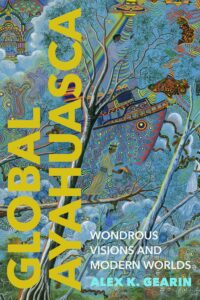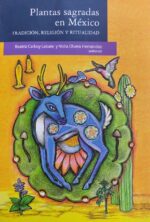- Ayahuasca Beyond Trauma – An Anthropological View - November 18, 2024
Broadly speaking, the visionary experiences that ayahuasca inspires can include so many things, including not only plant spirits and otherworldly encounters, but also mundane impressions that appear like memories or animated pictures. Examples of mundane impressions include a person seeing the garden in their previous home or a manager observing the layout of their workplace settings.
Other examples of the everyday include Indigenous narratives of visions that translocate sight to neighboring towns and distant cities or encounters with specific animal and plant persons. These are important for thinking about how social contexts entangle ayahuasca in direct and obvious ways. However, other strange dimensions and unbelievable worlds are frequent enough in high-dose experiences that whatever relation they may have to immediate social contexts, they can compel ayahuasca drinkers far beyond the here and now.
Considering this spectrum of experiences—from the mundane to the ineffable—I noticed a striking global pattern during my ethnographic research with ayahuasca drinkers in Australia, Peru, and China. Through interviews, observations, and surveys in these diverse settings, I noticed how ayahuasca, like other psychedelic substances, can profoundly alter one’s perception of time, dissolving the usual distinctions between past, present, and future. Yet, as the practice globalized through commercial healing networks, participants increasingly reported visionary and bodily sensations that drew them backward in time. They often engaged with trauma dynamics and became immersed in encounters with past events.
In the non-Indigenous settings I studied, the narratives of ayahuasca experiences frequently centered on themes of trauma.
This backward temporal orientation becomes especially apparent when contrasting Indigenous ayahuasca practices with commercial, non-Indigenous healing contexts. It is important to note that this observation does not extend to groups like Santo Daime, União do Vegetal, or other new religious movements, each of which presents unique cosmological and experiential approaches deserving explorations of their temporal dimensions.
In the non-Indigenous settings I studied, the narratives of ayahuasca experiences frequently centered on themes of trauma. Many participants perceived or encountered troubling aspects of their personal histories during the sessions.

This temporal orientation mirrors psychedelic-assisted therapies in North America and elsewhere that treat psychological and spiritual trauma. Rick Doblin, founder of the Multidisciplinary Association for Psychedelic Studies (MAPS) in the United States, recently set a nebulous goal of achieving what he called “net-zero trauma” by 2070, through the global rollout of psychedelic clinics. This was announced at the Psychedelic Science conference in 2023 in Denver, an event that attracted over 12,000 punters and more than 400 speakers—including myself speaking on a small stage about the limits of wonder in Shipibo tourism.
At the beginning of the conference, Former Texas governor Rick Perry took to the main stage to charismatically describe the promise of psychedelic treatments for helping US veterans heal their war trauma. As also seen in many other talks at the conference, the past had become a dominant temporal and therapeutic register of psychedelic experiences across the US, and also likely beyond in many other countries where trauma healing is popular.
This encountering of the past through psychedelic experiences contrasts with widespread Indigenous approaches that see the future when consuming ayahuasca (Harner 1973; Luna and Amaringo 1999; Gearin and Calavia Sáez 2021). During the 1980s, anthropologist Michael Brown (1986:166–168) explained that the Aguaruna he lived among did not believe everyone has a destiny or fated life plan that ayahuasca visions of the future displayed. A person’s ability to see the future was based on their shamanistic abilities. These practitioners, in essence, could generate futures through dieting and training with special plants that lend the power of clear psychospiritual sight.

In Amazonia, this has included seeing a successful hunt, observing outsiders coming to visit or the aggressive plans of the whites, and perceiving a prognosis for a patient. Shipibo healer Jose Lopez Sanchez envisioned an intergenerational future that is “fully situated in the present” and supported by shamanistic dieting and caring for special plants (2023). Anthropologists Emilia Sanabria and Silvia Mesturini Cappo described this as a “phytofuture” practice that involves “speculative gestures of bringing forth, growing, and multiplying” with plants through “collective imaginative practices” (2023). Speaking with a group of international guests at Pachamama Temple temple in 2019, just outside Yarinacocha, Peru, during a dedicated “educational class,” Shipibo Maestro Juan shared concerns about ayahuasca practices that focus on the past.
For a lot of the people that come here, ayahuasca shows them previous parts of their life. But this is where they block themselves, because healing is about going forward, not backwards. What we want is to be another kind of person, to be free. There are a lot of passengers [visitors] that say “no, in my life, this thing happened, to my dad, a lot of things,” and they forget what it is they want. Then when the ayahuasca shows them the things they’re thinking about, they move backwards. If they think, “I want to change my life. Those bad things that happened, I will put that behind me,” then ayahuasca makes some kind of program towards whatever is there if you move forward in your life.
It is an open question why many global psychedelic therapies focus on the past, especially the traumatic past, as the royal road to healing and spiritually flourishing with ayahuasca and other psychedelics. Alternate approaches, including across Amazonia, focus on the capacity to see possible futures when consuming the brew.
Anthropologist Bia Labate (2014) described how ayahuasca became more psychologized as it left Amazonia. In Amazonian ethnography, the meaning people ascribe to the source of sickness has typically not been a “traumatic” event, like in the psychedelic United States and elsewhere. Amazonia appears more ecological in the view that sickness can upset widespread social values of tranquillity and personal autonomy (Walker 2012; Rivière 1984; Rodd 2018). Healers may attempt to return the sick person—and their family members or others involved—to a state of tranquillity, while also juggling injustices, inequalities, and social tensions. In this way, the golden radiance of tranquillity in Amazonia is both an ideal and an affective atmosphere that entangles everyday life with ayahuasca curing practices. Seeing the future or past with ayahuasca can help to consolidate, or even to upset, the affective atmosphere of human and nonhuman tranquillity.
The golden radiance of tranquillity in Amazonia is both an ideal and an affective atmosphere that entangles everyday life with ayahuasca curing practices.
In his ethnography among Shuar settlements in Amazonia, Steven Rubenstein (2012) explored the curious absence of trauma among their warriors, which he compared with US war veterans. Despite sentiment training to prepare World War II American soldiers for killing, the Americans were traumatized primarily by the horror of shooting others, not the fear of being shot at. Rubenstein argued that this trauma is part of a symbolic emasculation of the soldiers in response to struggling to sufficiently embody the warfare attitudes of their commanders and the state (65). This he contrasted with the psychoactive enculturation of Shuar warriors during the mid-twentieth century.

Discover the Indigenous Reciprocity Initiative of the Americas
As part of a stateless society that valued personal autonomy highly, Shuar had drunk ayahuasca for various purposes, including to help young men gain the courage to commit homicide (Harner 1972; Rubenstein 2012). Boys would encounter a terrifying monster spirit in their ayahuasca experiences. Their objective was to receive its power by touching it. Shuar, as savvy fighters, managed to avoid working in the rubber and other industries of the European colonists. Their propensity for violence towards their enemies, while seemingly avoiding population-level trauma, sheds light on how distress may be embodied or absent across different social contexts.
This global distinction in temporal orientations of ayahuasca experiences that I have presented is crude and located among other temporal registers. Another major orientation in Amazonia would be a “present moment” state of the visions: what I called the “ambient present.” This includes when immediate social issues and everyday challenges appear in visionary experience and the lyrics of ayahuasca-drinking songs—including themes of finding lost objects, seeing inside people’s houses, and sorcery issues and fresh episodes of social antagonism. Second, there are plenty of past-dimensional aspects too, including in cosmogenic myths of the origins of life, plants, people, and animals. Reichel-Dolmatoff (1997) described a Tukano yagé initiation in the 1970s during which the neophyte drank ayahuasca and transformed his body-perception backwards in time, undergoing a kind of reverse bodily and fetal development, shrinking down to finally pierce through his mother’s body and enter the world of the ancestors.
There are clearly some biological and mental aspects to trauma, as found in epigenetic research and psychological symptomologies. But it appears there is also a dynamic social, historical, and narrative foundation to this.
Memory work and enduring visual and auditory media have probably inspired, or at least reinforced, some of the past-looking tendencies of those who identify psychological trauma as the core targets of existential transformation. The urban, neoshamanic cosmology of evoking an archaic and primordial world of the Indigenous rainforest has also helped to cast the experiences as past-oriented or as windows onto a prior condition, whether of the self, humanity, or the planet.
By contrast, the ambient-present and forward-looking orientations among some Indigenous ayahuasca practices speak to how the future could also address the past by orienting distress, hope, and healing variably in time and space.
Realizing that other approaches to healing with ayahuasca have not, or have barely, involved “trauma” should not diminish the relevance of trauma-based therapies, but it should encourage wider views of the possible temporal orientations within ayahuasca and its psychedelic sibling compounds.
Note: This article is adapted from the book Global Ayahuasca: Wondrous Visions and Modern Worlds (Stanford University Press, 2024) by anthropologist Alex K. Gearin.
Art by Karina Alvarez.
Brown, M. (1986). Tsewa’s gift: Magic and meaning in an Amazonian society. Smithsonian Institute.
Gearin, A. K., & Calavia Sáez, O. (2021). Altered visions: Sensory individualism and ayahuasca shamanism. Current Anthropology, 62(2), 138–163.
Harner, M. (Ed.). (1973). Hallucinogens and shamanism. Oxford University Press.
Harner, M. (1972). The Jivaro: People of the sacred waterfalls. Natural History Press.
Labate, B. (2014). The internationalization of Peruvian vegetalismo. In B. Labate & C. Cavnar (Eds.), Ayahuasca shamanism in the Amazon and beyond (pp. 71–85). Oxford University Press.
Lopez Sanchez, J. (2023). Planting the future. American Anthropologist, 125(3), 701–706.
Luna, L. E., & Amaringo, P. (1999) [1991]. Ayahuasca visions: The religious iconography of a Peruvian shaman. North Atlantic Books.
Reichel-Dolmatoff, G. (1997). Rainforest shamans: Essays on the Tukano Indians of the Northwest Amazon. Themis Books.
Rivière, P. (1984). Individual and society in Guiana. Cambridge University Press.
Rodd, R. (2018). Piaroa shamanic ethics and ethos: Living by the law and the good life of tranquillity. International Journal of Latin American Religions, 2(2), 315–333.
Rubenstein, S. L. (2012). On the importance of visions among the Amazonian Shuar. Current Anthropology, 53(1), 39–79.
Sanabria, E., & Mesturini Cappo, S. (2023). Introduction: Plot-ing phytofutures. American Anthropologist, 125(3), 673–678.
Walker, H. (2012). Under a watchful eye: Self, power, and intimacy in Amazonia. University of California Press.

Shop our Collection of Psychedelic T-Shirts
Take a minute to browse our stock:
Did you enjoy reading this article?
Please support Chacruna's work by donating to us. We are an independent organization and we offer free education and advocacy for psychedelic plant medicines. We are a team of dedicated volunteers!
Can you help Chacruna advance cultural understanding around these substances?

















